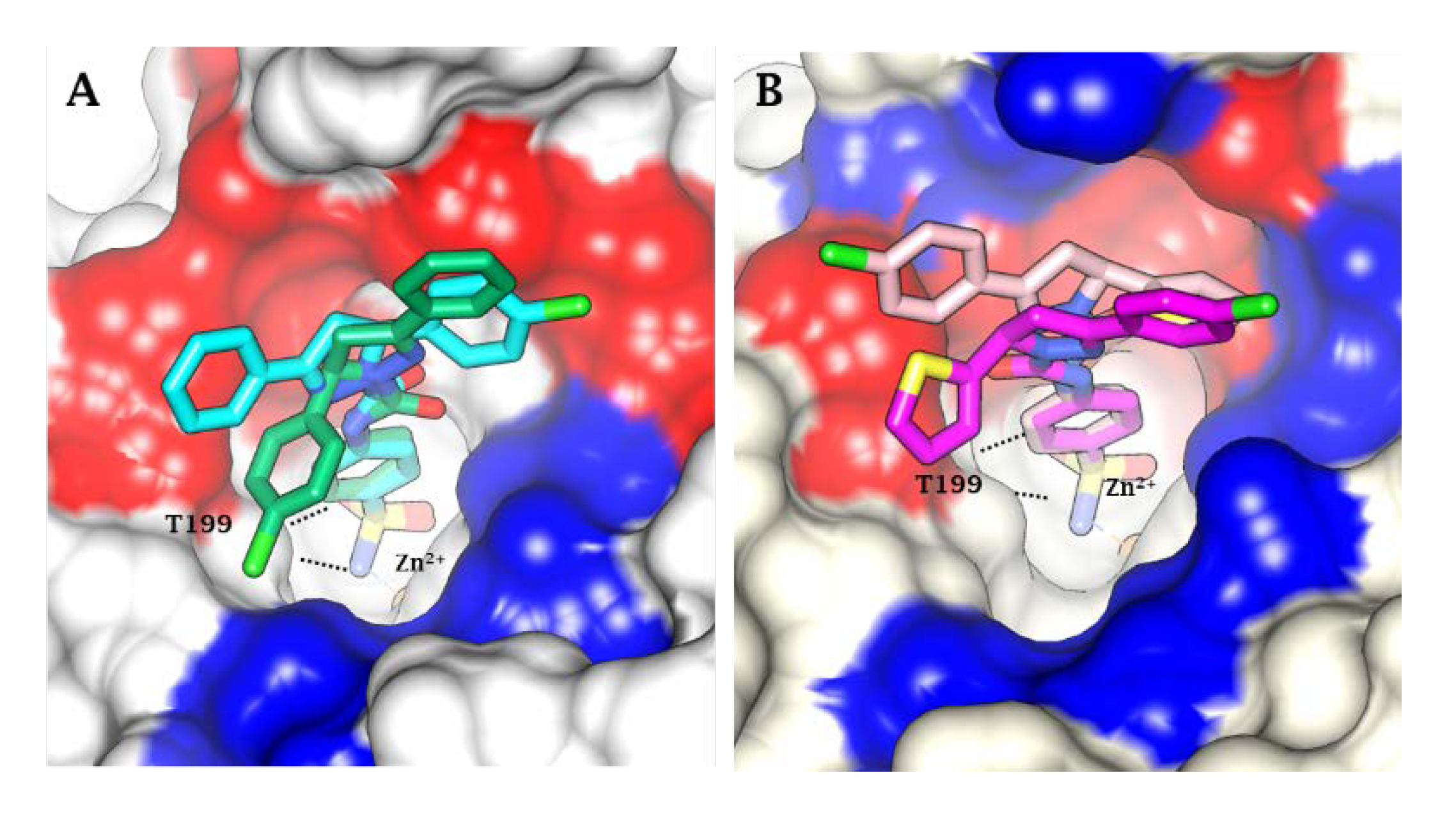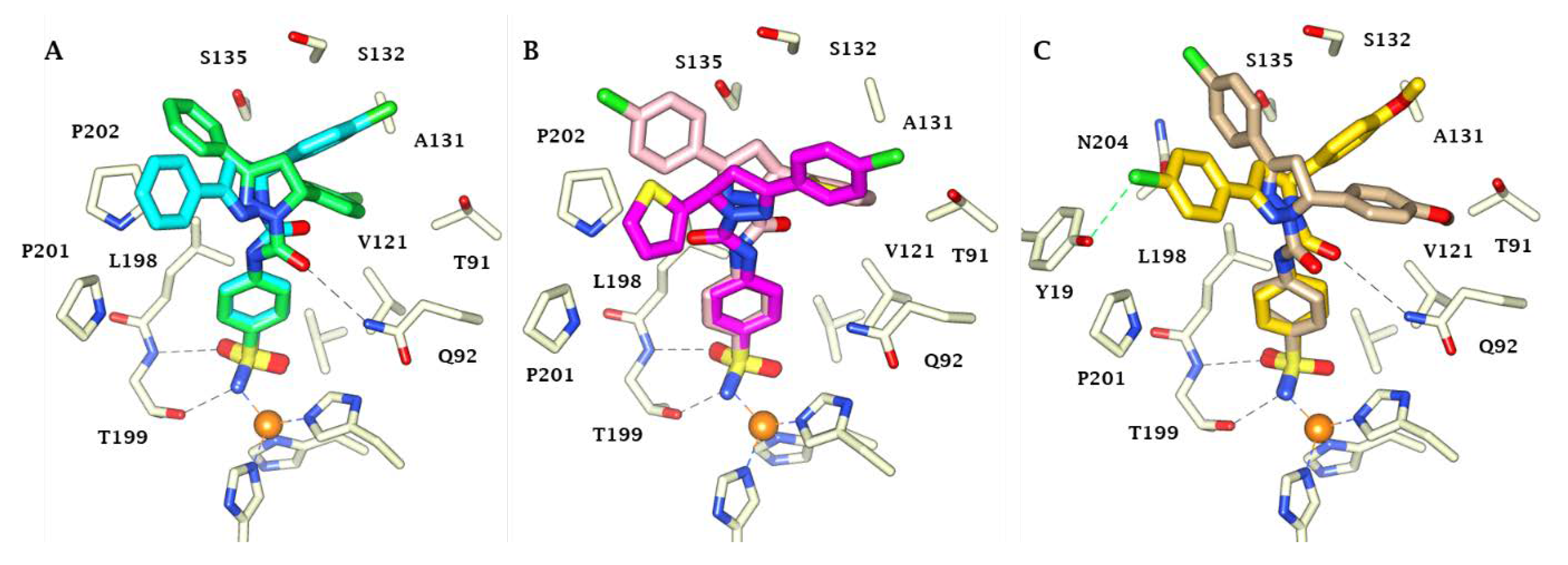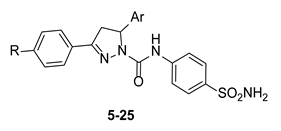Aryl-4,5-dihydro-1H-pyrazole-1-carboxamide Derivatives Bearing a Sulfonamide Moiety Show Single-digit Nanomolar-to-Subnanomolar Inhibition Constants against the Tumor-associated Human Carbonic Anhydrases IX and XII
Abstract
:1. Introduction
2. Results and Discussion
2.1. Chemistry
2.2. Carbonic Anhydrases Inhibition
2.3. Molecular Docking
3. Conclusions
4. Experimental Section
4.1. Chemistry
4.1.1. Synthesis of 4-ureidobenzenesulfonamide 2
4.1.2. Synthesis of 4-aminosulfonylphenyl Semicarbazide 3
4.1.3. Synthesis of (E)-1-(4-substituted phenyl)-3-substituted Aromatic prop-2-en-1-one 4 [20,21]
4.1.4. General Procedure for Synthesis of 3-phenyl-5-aryl-N-(4-sulfamoylphenyl)-4,5-dihydro-1H-pyrazole-1-carboxamide 5–25 [22]
3,5-Diphenyl-4,5-dihydro-pyrazole-1-carboxylic acid (4-sulfamoyl-phenyl)-amide 5
5-(4-Chlorophenyl)-3-phenyl-4,5-dihydro-pyrazole-1-carboxylic acid (4-sulfamoyl-phenyl)-amide 6
5-(4-Flurophenyl)-3-phenyl-4,5-dihydro-pyrazole-1-carboxylic acid (4-sulfamoyl-phenyl)-amide 7
5-(2-Chloro-6-fluorophenyl)-3-phenyl-4, 5-dihydro-pyrazole-1-carboxylic acid (4-sulfamoyl-phenyl)-amide 8
3-Phenyl-5-thiophene-2-yl-4, 5-dihydro-pyrazole-1-carboxylic acid (4-sulfamoyl-phenyl)-amide 9
5-Anthracene-9-yl-3-phenyl-4,5-dihydro-pyrazole-1-carboxylic acid (4-sulfamoyl-phenyl)-amide 10
5-(2,4-Dichlorophenyl)-3-phenyl-4, 5-dihydro-pyrazole-1-carboxylic acid (4-sulfamoyl-phenyl)-amide 11
3-(4-Chlorophenyl)-5-phenyl-N-(4-sulfamoylphenyl)-4,5-dihydro-1H-pyrazole-1-carboxamide 12
3-(4-Chlorophenyl)-N-(4-sulfamoylphenyl)-5-(p-tolyl)-4,5-dihydro-1H-pyrazole-1-carboxamide 13
3,5-Bis(4-chlorophenyl)-N-(4-sulfamoylphenyl)-4,5-dihydro-1H-pyrazole-1-carboxamide 14
3-(4-Chlorophenyl)-5-(4-fluorophenyl)-N-(4-sulfamoylphenyl)-4,5-dihydro-1H-pyrazole-1-carboxamide 15
5-(2-Chlorophenyl)-3-(4-chlorophenyl)-N-(4-sulfamoylphenyl)-4,5-dihydro-1H-pyrazole-1-carboxamide 16
3-(4-Chlorophenyl)-5-(2,4-dichlorophenyl)-N-(4-sulfamoylphenyl)-4,5-dihydro-1H-pyrazole-1-carboxamide 17
3-(4-Chlorophenyl)-N-(4-sulfamoylphenyl)-5-(thiophen-2-yl)-4,5-dihydro-1H-pyrazole-1-carboxamide 18
5-(2-Chloro-6-fluorophenyl)-3-(4-chlorophenyl)-N-(4-sulfamoylphenyl)-4,5-dihydro-1H-pyrazole-1-carboxamide 19
3-(4-Chlorophenyl)-5-(2-hydroxyphenyl)-N-(4-sulfamoylphenyl)-4,5-dihydro-1H-pyrazole-1-carboxamide 20
3-(4-Chlorophenyl)-5-(4-methoxyphenyl)-N-(4-sulfamoylphenyl)-4,5-dihydro-1H-pyrazole-1-carboxamide 21
3-(4-Chlorophenyl)-5-(3,4-dimethoxyphenyl)-N-(4-sulfamoylphenyl)-4,5-dihydro-1H-pyrazole-1-carboxamide 22
3-(4-Bromophenyl)-5-phenyl-45-dihydro-pyrazole-1-carboxylic acid (4-sulfamoyl-phenyl)-amide 23
3-(4-Bromophenyl)-5-(4-chloro phenyl)-4,5-dihydro-pyrazole-1-carboxylic acid (4-sulfamoyl-phenyl)-amide 24
3-(4-Bromo phenyl)-5-(4-fluro phenyl)-4, 5-dihydro-pyrazole-1-carboxylic acid (4-sulfamoyl-phenyl)-amide 25
4.2. CA Inhibition
4.3. Molecular Docking
Author Contributions
Funding
Conflicts of Interest
References
- Smith, K.S.; Jakubzick, C.; Whittam, T.S.; Ferry, J.G. Carbonic anhydrase is an ancient enzyme widespread in prokaryotes. Proc. Natl. Acad. Sci. USA 1999, 96, 15184–15189. [Google Scholar] [CrossRef] [Green Version]
- Supuran, C.T. Carbonic anhydrases: Novel therapeutic applications for inhibitors and activators. Nat. Rev. Drug Discov. 2008, 7, 168–181. [Google Scholar] [CrossRef]
- Alterio, V.; Di Fiore, A.; D’Ambrosio, K.; Supuran, C.T.; De Simone, G. Multiple Binding Modes of Inhibitors to Carbonic Anhydrases: How to Design Specific Drugs Targeting 15 Different Isoforms? Chem Rev. 2012, 112, 4421. [Google Scholar] [CrossRef] [Green Version]
- Nocentini, A.; Supuran, C.T. Carbonic Anhydrases: An Overview. In Carbonic Anhydrases; Nocentini, A., Supuran, C.T., Eds.; Elsevier: Amsterdam, The Netherlands, 2019; pp. 3–16. [Google Scholar]
- Neri, D.; Supuran, C.T. Interfering with pH regulation in tumors as a therapeutic strategy. Nat. Rev. Drug Discov. 2011, 10, 767–777. [Google Scholar] [CrossRef] [Green Version]
- Nocentini, A.; Supuran, C.T. Carbonic anhydrase inhibitors as antitumor/antimetastatic agents: A patent review (2008-2018). Expert Opin. Ther. Pat. 2018, 28, 729–740. [Google Scholar] [CrossRef]
- Alterio, V.; Hilvo, M.; Di Fiore, A.; Supuran, C.T.; Pan, P.; Parkkila, S.; Scaloni, A.; Pastorek, J.; Pastorekova, S.; Pedone, C.; et al. Crystal structure of the catalytic domain of the tumor-associated human carbonic anhydrase IX. Proc. Natl. Acad. Sci. USA 2009, 106, 16233–16238. [Google Scholar] [CrossRef] [Green Version]
- Whittington, D.A.; Waheed, A.; Ulmasov, B.; Shah, G.N.; Grubb, J.H.; Sly, W.S.; Christianson, D.W. Crystal structure of the dimeric extracellular domain of human carbonic anhydrase XII, a bitopic membrane protein overexpressed in certain cancer tumor cells. Proc. Natl. Acad. Sci. USA 2001, 98, 9545–9550. [Google Scholar] [CrossRef] [PubMed] [Green Version]
- Supuran, C.T.; Alterio, V.; Di Fiore, A.; D’Ambrosio, K.; Carta, F.; Monti, S.M.; De Simone, G. Inhibition of carbonic anhydrase IX targets primary tumors, metastases, and cancer stem cells: Three for the price of one. Med. Res. Rev. 2018, 38, 1799–1836. [Google Scholar] [CrossRef] [PubMed]
- Pastorekova, S.; Parkkila, S.; Zavada, J. Tumor-associated carbonic anhydrases and their clinical significance. Adv. Clin. Chem. 2006, 42, 167–216. [Google Scholar] [PubMed]
- Supuran, C.T. How many carbonic anhydrase inhibition mechanisms exist. J. Enzyme Inhib. Med. Chem. 2016, 31, 345–360. [Google Scholar] [CrossRef]
- Nocentini, A.; Supuran, C.T. Advances in the structural annotation of human carbonic anhydrases and impact on future drug discovery. Expert Opin. Drug Discov. 2019, 14, 1175–1197. [Google Scholar] [CrossRef] [PubMed]
- Lomelino, C.L.; Andring, J.T.; McKenna, R. Crystallography and its impact on carbonic anhydrase research. Int. J. Med. Chem. 2018, 2018, 9419521. [Google Scholar] [CrossRef] [PubMed] [Green Version]
- Pacchiano, F.; Carta, F.; McDonald, P.C.; Lou, Y.; Vullo, D.; Scozzafava, A.; Dedhar, S.; Supuran, C.T. Ureido-Substituted Benzenesulfonamides Potently Inhibit Carbonic Anhydrase IX and Show Antimetastatic Activity in a Model of Breast Cancer Metastasis. J. Med. Chem. 2011, 54, 1896–1902. [Google Scholar] [CrossRef] [PubMed] [Green Version]
- Welichem Biotech Incorporated. Safety Study of SLC-0111 in Subjects with Advanced Solid Tumours; NCT02215850; Welichem Biotech Incorporated: Vancouver, BC, Canada.
- Pichake, J.; Kharkar, P.; Ceruso, M.; Supuran, C.T.; Toraskar, M.P. Carbonic Anhydrase Inhibitors: Design, Synthesis and Biological Evaluation of Novel Sulfonyl Semicarbazide Derivatives. ACS Med. Chem. Lett. 2014, 5, 793–796. [Google Scholar] [CrossRef] [Green Version]
- Singasane, N.; Kharkar, P.; Ceruso, M.; Supuran, C.T.; Toraskar, M.P. Inhibition of carbonic anhydrase isoforms I, II, IX and XII with Schiff’s bases incorporating iminoureido moieties. J. Enzyme Inhib. Med. Chem. 2015, 30, 901–907. [Google Scholar] [CrossRef] [Green Version]
- Khalifah, R.G. The carbon dioxide hydration activity of carbonic anhydrase. J. Biol. Chem. 1971, 246, 2561–2573. [Google Scholar]
- Leitans, J.; Kazaks, A.; Balode, A.; Ivanova, J.; Zalubovskis, R.; Supuran, C.T.; Tars, K. Efficient expression and Crystallization system of cancer-associated carbonic anhydrase isoform IX. J. Med. Chem. 2015, 58, 9004–9009. [Google Scholar] [CrossRef]
- Vogel, A.; Furniss, B.; Hannaford, A.; Tatchell, A.R.; Smith, P.W.G. Vogel’s Textbook of Practical Organic Chemistry, 5th ed.; Longman: Harlow, UK, 1989. [Google Scholar]
- Singhal, M.; Paul, A.; Singh, H. Design, Synthesis and Biological Evaluation of 2-Methylphenyl Semicarbazone Derivatives. Bangladesh J. Pharmacol. 2011, 6, 1–7. [Google Scholar] [CrossRef] [Green Version]
- Khalil, N.; Ahmed, E.; El-Nassan, H. Synthesis, Characterization and Biological Evaluation of Certain 1, 3-Thiazolone Derivatives Bearing Pyrazoline Moiety as Potential Anti-Breast Cancer Agents. Med. Chem. Res. 2013, 22, 1021–1027. [Google Scholar] [CrossRef]
- Krasavin, M.; Shetnev, A.; Baykov, S.; Kalinin, S.; Nocentini, A.; Sharoyko, V.; Poli, G.; Tuccinardi, T.; Korsakov, M.; Tennikova, T.B.; et al. Pyridazinone-substituted benzenesulfonamides display potent inhibition of membrane-bound human carbonic anhydrase IX and promising antiproliferative activity against cancer cell lines. Eur. J. Med. Chem. 2019, 168, 301–314. [Google Scholar] [CrossRef]
- Abdel-Aziz, A.A.; El-Azab, A.S.; Bua, S.; Nocentini, A.; Abu El-Enin, M.A.; Alanazi, M.M.; AlSaif, N.A.; Hefnawy, M.M.; Supuran, C.T. Design, synthesis, and carbonic anhydrase inhibition activity of benzenesulfonamide-linked novel pyrazoline derivatives. Bioorg. Chem. 2019, 87, 425–431. [Google Scholar] [CrossRef] [PubMed]
- Moi, D.; Nocentini, A.; Deplano, A.; Balboni, G.; Supuran, C.T.; Onnis, V. Structure-activity relationship with pyrazoline-based aromatic sulfamates as carbonic anhydrase isoforms I, II, IX and XII inhibitors: Synthesis and biological evaluation. Eur. J. Med. Chem. 2019, 182, 111638. [Google Scholar] [CrossRef] [PubMed]
- Vats, L.; Kumar, R.; Bua, S.; Nocentini, A.; Gratteri, P.; Supuran, C.T.; Sharma, P.K. Continued exploration and tail approach synthesis of benzenesulfonamides containing triazole and dual triazole moieties as carbonic anhydrase I, II, IV and IX inhibitors. Eur. J. Med. Chem. 2019, 183, 111698. [Google Scholar] [CrossRef] [PubMed]
- Rogato, A.; Del Prete, S.; Nocentini, A.; Carginale, V.; Supuran, C.T.; Capasso, C. Phaeodactylum tricornutum as a model organism for testing the membrane penetrability of sulphonamide carbonic anhydrase inhibitors. J. Enzyme Inhib. Med. Chem. 2019, 34, 510–518. [Google Scholar] [CrossRef] [PubMed] [Green Version]
- Schrödinger Suite Release 2019-1; Schrödinger, LLC: New York, NY, USA, 2019; (a) Prime, v.5.5; Maestro v.11.9; (b) Epik, v.4.7; (c) Impact, v.8.2; (d) Macromodel v.12.3. (e) Glide, v.8.2.
- Nocentini, A.; Gratteri, P.; Supuran, C.T. Phosphorus versus Sulfur: Discovery of Benzenephosphonamidates as Versatile Sulfonamide-Mimic Chemotypes Acting as Carbonic Anhydrase Inhibitors. Chemistry 2019, 25, 1188–1192. [Google Scholar] [CrossRef] [PubMed]
- Nocentini, A.; Bonardi, A.; Gratteri, P.; Cerra, B.; Gioiello, A.; Supuran, C.T. Steroids interfere with human carbonic anhydrase activity by using alternative binding mechanisms. J. Enzyme Inhib. Med. Chem. 2018, 33, 1453–1459. [Google Scholar] [CrossRef] [PubMed] [Green Version]
- Nocentini, A.; Carta, F.; Tanc, M.; Selleri, S.; Supuran, C.T.; Bazzicalupi, C.; Gratteri, P. Deciphering the Mechanism of Human Carbonic Anhydrases Inhibition with Sulfocoumarins: Computational and Experimental Studies. Chemistry 2018, 24, 7840–7844. [Google Scholar] [CrossRef]






| Cmpd | R | Ar | KI (nM) | ||||
|---|---|---|---|---|---|---|---|
| CA I | CA II | CA VII | CA IX | CA XII | |||
| 5 | H | C6H5 | 382 | 67.3 | 33.2 | 1.3 | 7.7 |
| 6 | H | 4-Cl-C6H4 | 36.2 | 8.2 | 7.7 | 1.4 | 1.2 |
| 7 | H | 4-F-C6H4 | 252 | 58.2 | 2.3 | 1.5 | 6.3 |
| 8 | H | 2-Cl-6-F-C6H3 | 38.3 | 5.2 | 2.4 | 1.5 | 1.4 |
| 9 | H | thiophen-2-yl | 185 | 5.2 | 1.9 | 1.4 | 2.5 |
| 10 | H | anthracene-9-yl | 293 | 7.1 | 2.4 | 1.3 | 6.8 |
| 11 | H | 2,4-diCl-C6H3 | 39.5 | 5.4 | 2.5 | 1.4 | 0.84 |
| 12 | Cl | C6H5 | 239 | 233 | 350 | 16.5 | 9.2 |
| 13 | Cl | 4-CH3-C6H4 | 66.7 | 12.3 | 4.5 | 2.9 | 9.2 |
| 14 | Cl | 4-Cl-C6H4 | 237.9 | 12.7 | 3.3 | 11.4 | 1.1 |
| 15 | Cl | 4-F-C6H4 | 616.7 | 71.3 | 3.2 | 2.7 | 1.0 |
| 16 | Cl | 2-Cl-C6H4 | 296.6 | 8.8 | 4.3 | 8 | 1.7 |
| 17 | Cl | 2,4-diCl-C6H3 | 769.6 | 13.5 | 27.6 | 15 | 1.3 |
| 18 | Cl | thiophen-2-yl | 726 | 9.2 | 2.9 | 2.5 | 0.62 |
| 19 | Cl | 2-Cl-6-F-C6H3 | 42.7 | 10.8 | 2.3 | 2.7 | 6.8 |
| 20 | Cl | 2-OH-C6H4 | 74.2 | 7.6 | 2.1 | 76.6 | 0.99 |
| 21 | Cl | 4-OCH3-C6H4 | 367.7 | 9.4 | 2.7 | 2.8 | 0.82 |
| 22 | Cl | 3,4-diOCH3-C6H3 | 165.9 | 9.3 | 2.3 | 2.2 | 1.5 |
| 23 | Br | C6H5 | 44.4 | 6.3 | 2.9 | 1.4 | 6.7 |
| 24 | Br | 4-Cl-C6H4 | 45.5 | 10.7 | 2.7 | 14.3 | 0.89 |
| 25 | Br | 4-F-C6H4 | 38.2 | 5.5 | 2.6 | 1.4 | 2.4 |
| AAZ | - | 250 | 12.1 | 2.5 | 25 | 5.8 | |
| Cmpd | GlideScore (kcal/mol) | Cmpd | GlideScore (kcal/mol) | ||
|---|---|---|---|---|---|
| CA IX | CA XII | CA IX | CA XII | ||
| (S)-5 | −6.82 | −6.02 | (R)-5 | −5.34 | −6.84 |
| (S)-6 | −6.54 | −6.28 | (R)-6 | −5.67 | −7.01 |
| (S)-7 | −6.93 | −5.63 | (R)-7 | −5.39 | −6.49 |
| (S)-8 | −6.28 | −6.45 | (R)-8 | −5.38 | −7.36 |
| (S)-9 | −6.34 | −6.63 | (R)-9 | −5.94 | −7.57 |
| (S)-10 | −7.01 | −6.22 | (R)-10 | −5.68 | −6.82 |
| (S)-11 | −6.35 | −5.96 | (R)-11 | −5.02 | −7.69 |
| (S)-12 | −5.86 | −6.29 | (R)-12 | −5.49 | −6.57 |
| (S)-13 | −6.57 | −6.07 | (R)-13 | −5.79 | −7.03 |
| (S)-14 | −6.02 | −6.38 | (R)-14 | −5.38 | −7.51 |
| (S)-15 | −6.83 | −5.99 | (R)-15 | −5.46 | −7.36 |
| (S)-16 | −6.12 | −6.23 | (R)-16 | −5.82 | −7.15 |
| (S)- 17 | −5.84 | −6.54 | (R)- 17 | −5.09 | −7.64 |
| (S)- 18 | −6.14 | −6.08 | (R)- 18 | −5.97 | −7.92 |
| (S)- 19 | −6.72 | −6.63 | (R)- 19 | −5.01 | −7.29 |
| (S)- 20 | −5.67 | −6.41 | (R)- 20 | −5.26 | −6.86 |
| (S)- 21 | −6.35 | −6.39 | (R)- 21 | −6.03 | −7.27 |
| (S)- 22 | −6.92 | −6.28 | (R)- 22 | −6.05 | −7.16 |
| (S)- 23 | −6.54 | −6.92 | (R)- 23 | −5.65 | −6.48 |
| (S)- 24 | −6.24 | −6.47 | (R)- 24 | −5.24 | −7.58 |
| (S)- 25 | −6.82 | −6.19 | (R)- 25 | −5.37 | −7.22 |
| AAZ | −6.31 | −7.35 | |||
© 2020 by the authors. Licensee MDPI, Basel, Switzerland. This article is an open access article distributed under the terms and conditions of the Creative Commons Attribution (CC BY) license (http://creativecommons.org/licenses/by/4.0/).
Share and Cite
Hargunani, P.; Tadge, N.; Ceruso, M.; Leitans, J.; Kazaks, A.; Tars, K.; Gratteri, P.; Supuran, C.T.; Nocentini, A.; Toraskar, M.P. Aryl-4,5-dihydro-1H-pyrazole-1-carboxamide Derivatives Bearing a Sulfonamide Moiety Show Single-digit Nanomolar-to-Subnanomolar Inhibition Constants against the Tumor-associated Human Carbonic Anhydrases IX and XII. Int. J. Mol. Sci. 2020, 21, 2621. https://doi.org/10.3390/ijms21072621
Hargunani P, Tadge N, Ceruso M, Leitans J, Kazaks A, Tars K, Gratteri P, Supuran CT, Nocentini A, Toraskar MP. Aryl-4,5-dihydro-1H-pyrazole-1-carboxamide Derivatives Bearing a Sulfonamide Moiety Show Single-digit Nanomolar-to-Subnanomolar Inhibition Constants against the Tumor-associated Human Carbonic Anhydrases IX and XII. International Journal of Molecular Sciences. 2020; 21(7):2621. https://doi.org/10.3390/ijms21072621
Chicago/Turabian StyleHargunani, Priya, Nikhil Tadge, Mariangela Ceruso, Janis Leitans, Andris Kazaks, Kaspars Tars, Paola Gratteri, Claudiu T. Supuran, Alessio Nocentini, and Mrunmayee P. Toraskar. 2020. "Aryl-4,5-dihydro-1H-pyrazole-1-carboxamide Derivatives Bearing a Sulfonamide Moiety Show Single-digit Nanomolar-to-Subnanomolar Inhibition Constants against the Tumor-associated Human Carbonic Anhydrases IX and XII" International Journal of Molecular Sciences 21, no. 7: 2621. https://doi.org/10.3390/ijms21072621
APA StyleHargunani, P., Tadge, N., Ceruso, M., Leitans, J., Kazaks, A., Tars, K., Gratteri, P., Supuran, C. T., Nocentini, A., & Toraskar, M. P. (2020). Aryl-4,5-dihydro-1H-pyrazole-1-carboxamide Derivatives Bearing a Sulfonamide Moiety Show Single-digit Nanomolar-to-Subnanomolar Inhibition Constants against the Tumor-associated Human Carbonic Anhydrases IX and XII. International Journal of Molecular Sciences, 21(7), 2621. https://doi.org/10.3390/ijms21072621








